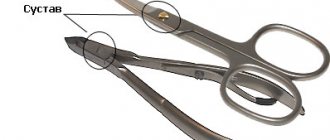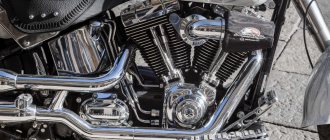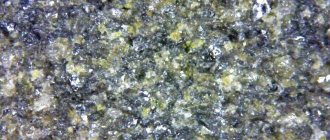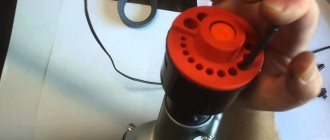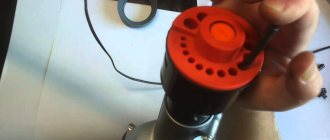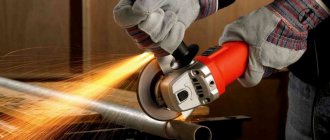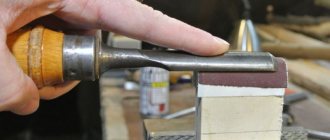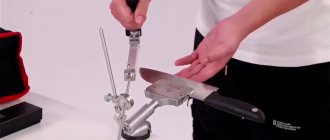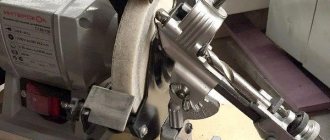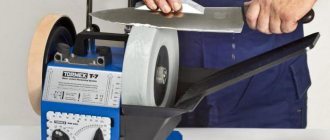To restore the attractiveness of your nails and remove interfering hangnails, you need to use tweezers, scissors, and a file. However, after prolonged use of these devices, the cutting edges become dull. To restore their sharpness, you need to know how to sharpen manicure tools.
Set of manicure tools
What types of sharpening are there?
There are two types of sharpening manicure tools. Each of them has certain features that need to be taken into account when restoring sharpness and working with cutting edges:
- Factory - contrary to the opinion of many people, it is considered a bad option for high-quality, long-term work. The edges do not cut materials along the entire length, and sharpening is not completed. If the working parts are sharp, they will become dull much faster than after professional sharpening.
- Manual - sharpening of manicure tools, which is performed using various devices. These include diamond bars and round abrasive stones. The quality depends on the chosen method of sharpening and the skill of the person.
We must not forget that manual sharpening requires perseverance and attentiveness from the master.
Machine selection
Depending on the planned scale of work, you can purchase the following equipment:
- for sharpening wire cutters and scissors;
- for sharpening manicure and hairdressing tools;
- multifunctional device for straightening manicure, hairdressing and medical instruments, drills;
- for straightening hair clippers.
All listed equipment belongs to the professional category. It can also be used for sharpening drills, tailor's scissors, tweezers, meat grinder knives, cosmetic needles, dental nippers and probes, and kitchen knives. When choosing, you should pay attention to the availability of abrasive wheels from this company.
Sharpening scissors on a machine in the video:
What professional equipment is used for sharpening manicure tools?
Sharpening of manicure tools is carried out in specialized workshops. The cost of sharpening depends on the type of device, the level of skill of the worker, and the status of the workshop. The average price is 300 rubles.
Due to the fact that sharpening can cost quite a bit of money, many manicurists advise ordering a similar procedure when it comes to working with expensive, high-quality tools that would be a shame to ruin if you try to sharpen them yourself.
To perform the procedure, craftsmen use specialized machines:
- Laser - modern high-precision installations that allow you to work equally effectively with different alloys and metals.
- Mechanical - common machines that are equipped with diamond-coated round grinding wheels.
Working with mechanical equipment is much more difficult. This is due to the fact that you need to choose the right number of revolutions and use water cooling. In addition to this, it is necessary to slowly move the cutting edge relative to the abrasive so that turning occurs evenly along its entire length.
Sharpening small tools
Sharpening tools at home
Before you start sharpening cuticle nippers, tweezers, files, tweezers, you need to prepare the equipment for the procedure:
- sharpening stones of different grain sizes (for rough and finishing);
- sheets of foil;
- sandpaper;
- napkins;
- file.
Sharpening different tools involves carrying out certain actions sequentially one after another. It is necessary to talk in more detail about each of the methods of carrying out procedures.
Cuticle nippers
Step-by-step instructions for sharpening nail clippers at home:
- Initially, you need to eliminate the backlash. To do this, you need to open the wire cutters, place them on the table, and lightly tap them with a hammer.
- Clean the joints and cutting edges from dirt and dust. Degrease them.
- Use a file to remove rough edges from the blades. Movements should be leisurely.
- Close the cutters. Place them on the table, the edges should be on top. Use smooth movements of the file to remove irregularities.
Using a fine-grain stone (about 8000 grit), go along the cutting edges. After this, lubricate the moving element with oil.
Nail clippers
Nail clippers can be sharpened using sharpening stones of different grits or sandpaper. Step-by-step instruction:
- Clean the tweezers from dirt and debris.
- Degrease working parts with alcohol.
- Sand them with coarse, finishing sandpaper. Remove visual irregularities. Run your fingers along the edges. If the metal scratches the skin, you need to repeat the treatment with an abrasive.
Remove metal dust with a cloth.
File
Nail files made from glass are becoming increasingly popular. Their advantage is that after processing the nail plates, they do not delaminate. If the file becomes dull, there is no need to throw it away. You need to take the tool to a specialized workshop for resharpening.
Tweezers
Tweezers are a secondary manicure tool. Sharpening it is no different from the procedure for sharpening cuticle nippers.
Technology for sharpening nail clippers.
Today's lesson is very important for novice sharpeners, since correct sharpening of nail clippers is a precise and responsible task. We can say that nail clippers are one of the most difficult tools to sharpen. I know from my practice that beginners quickly master sharpening scissors than nail clippers, since the operating principle and geometry of the clippers are different from scissors and getting the right angles is sometimes difficult even for experienced craftsmen.
The step-by-step sharpening technology is as follows.
Step 1. Check the joint of the pliers for play, which is present in 90% of tweezers received for sharpening. Backlash is detected by wobbling of the blades of the pliers in the joint, and without eliminating it, sharp cutting edges have no meaning. When we are sure that the play has been eliminated in both cases, we lubricate the joint of the pliers with machine oil and clamp and unclench several times. If the joint is dirty, let the dirt (or rust) soak in the oil for several minutes.
Step 2. Now let's work on the blades of the nippers, which are the main critical area when sharpening. We sharpen the blades from the inside. According to A. Sharp’s method, this operation can be performed efficiently on the ShM-36 Supermaster or ZAT-36U machines:
Step 3. We sharpen the blades from the outside, correct the tips and visually verify the sharpness of the cutting edge.
Step4. After this, we take a piece of leather and, holding the blade with a piece of leather on both sides, we pinch it and pull it towards us. Then we clean the blade from unnecessary particles with cotton wool. We perform this procedure with both blades. We clamp the pliers and look at the gap against a light background. Next, we hold the pliers with our left hand and turn the blades upward.
Step 5. Place the pliers with the blades up, as they should lie correctly, with your right hand, carefully file with a fine-grained diamond stone and trim the contact area. This operation must be performed carefully so as not to spoil the geometry of the blade. We file until the mirror line on the edge of the blade is barely visible. Let's unclench and see what both blades have covered in this operation. Now we clean the blades from microparticles, first with a piece of leather, then with cotton wool. If, when viewed through the light, we see tight contact between the cutting edges... then you can check the sharpness of the blades. This is done on a thin and soft polyethylene film. If the nippers leave an even cut, then the nippers are sharp. And if they pull the film, then repeat the listed procedures until the desired result is obtained.
Here I have outlined the sharpening technology, and you will learn more about this in my book “Secrets of Professional Sharpening.”
Now let’s talk about the tool base and what to use for sharpening. There are different methods of sharpening, from manual sharpening on a diamond stone to performing this procedure on a precision machine. Although they are performed in different ways. But still, they are all called manual sharpening.
The difference between the traditional method (on the left) and the new technology (A. Sharp’s method on the right) of sharpening manicure and hairdressing instruments.
1. This method requires skill and long-term experience, and achieving high-quality sharpening is a difficult task, especially for a beginner.
2. The circle runout is large. The larger the circle, the more radial or planar runout occurs. It is difficult to escape from this law, so sharpening on small wheels turns out to be more accurate and of higher quality.
3. There is no rigid fixation of the workpiece (all metalworking machines operate on this principle) and with one awkward movement of the hands, the tool can be easily rejected. Therefore, not only beginners, but also experienced craftsmen have a fear of ruining the client’s instrument.
4. As a consequence of the above points, with this method it is difficult to achieve a clear closure of the cutting edges, and therefore high-quality sharpness, as in A. Sharp’s method. Below in the video, see a fragment of work using this method
I have been sharpening this way for a long time and my clients know about the quality of my sharpening. This method is effective not only for standard sharpening, but also for restoring the geometry of deformed blades of wire cutters.
And if you have a need for urgent repair of power tools, sharpening or sharpening training, you can call +7-920-216-14-57 (free Whats Up, Viber).
How and with what to check the sharpening level?
After carrying out the procedure for resharpening manicure tools, it is necessary to check its sharpness. To do this, you can try cutting several materials:
- stretch film;
- vinyl or latex gloves;
- plastic bag;
- wet wipe.
There should be no difficulty in cutting. If you have to apply more force, you need to treat the working parts with abrasive again. In addition to cutting, you can determine the sharpness by running your fingers along the cutting edge without pressing. Metal should not cling to the skin or leave marks.
Latex gloves for testing sharpness
Useful tips
Recommendations:
- Inexpensive tools do not need to be taken apart. Poor quality fasteners may not withstand being disconnected and reconnected.
- When working with a sharpening machine, it is necessary to set low speed. High rotation speed will damage the cutting edge.
- After purchasing a tool, you need to remember its angle. It must be adhered to during sharpening.
- If you need to sharpen professional manicure tools, it is advisable to use the services of professionals. Carrying out the procedure yourself requires practical experience. To do this, you can practice on old instruments.
- Wear safety glasses when operating the sharpening machine.
- Bars less than 8000 grit are used to smooth out serious damage and chips. If there are no such problems, you should not choose stones less than 8000 grit.
- Do not forget about regular lubrication of moving elements with oil (machine oil, vegetable oil).
- Store tools in a dry case without access to moisture. Constant moisture will cause rust to form.
- After work, clean tweezers, scissors, files, tweezers from dirt and debris.
- A simple option to restore the sharpness of nail scissors is to cut the foil. The sharper the blades are needed, the more cuts required.
It is strictly forbidden to change the angle of the cutting edges, which was made by the manufacturer.
Sharpening manicure instruments is a responsible procedure that will help restore sharpness and perform work more efficiently. However, in order not to permanently spoil the cutting edges, it is necessary to take into account a number of nuances and recommendations of professionals. If it is not possible to spend enough time for sharpening, you need to contact a specialized workshop.
Machine device
hairdressing tools sharpening machine
A sharpening machine is an electric motor with a shaft onto which a faceplate and a sharpening disk are mounted. There are two types of machines: with a horizontal faceplate and a vertical one. The former are convenient for working with almost any type of surgical, hairdressing and manicure instruments.
The most technologically advanced equipment models are equipped with a laser “sight” or a manipulator that helps set the sharpening angle of drills. Even a beginner can cope with a complex and painstaking procedure on such a machine. You can also set the disk speed that is optimal for each specific tool.
The transparent protective visor prevents harmful dust from flying away and protects the technician. High-quality equipment is produced in Germany and the USA and is quite expensive. The cheapest machine without a manipulator will cost approximately 45 thousand rubles.
The peculiarity of equipment for sharpening hairdressing and manicure instruments is the increased mechanical requirements. The runout of the spindle on which the faceplate is mounted is completely eliminated. The abrasive surface must move perfectly in the plane, otherwise the required accuracy cannot be achieved. Acceptable runout standards are indicated in the passport and are no more than 0.11 with a sharpening disc on.
In the workshop, the machine works all day, so the speed and quality of the work depends on the accuracy of rotation of the faceplate with the attached grinding disc. High-quality equipment operates for a long time without wear of rubbing and moving mechanisms and bearings.
Technical characteristics of the machines:
- Dimensions: this is a mobile desktop equipment;
- reverse: a useful option for finishing many tools;
- disc sizes: from 150 to 240 mm;
- rotation speed adjustment up to 3 thousand revolutions per minute;
- electric motor: in this case, power is not so important, so it usually does not exceed 300 W, but they are characterized by quiet operation and do not overheat due to ventilation;
- machine weight: about 30 kg.
The kit includes spare abrasive discs, a wheel and polishing paste. The legs are equipped with rubber pads that dampen vibration.
